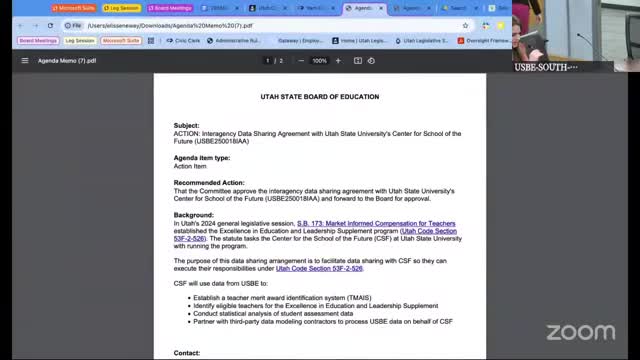Committee approves data-sharing agreement with Utah State Center for School of the Future after debate over scope and student privacy
January 11, 2025 | Financial Operations , Utah Board of Education, Offices, Departments, and Divisions, Organizations, Utah Executive Branch, Utah
This article was created by AI summarizing key points discussed. AI makes mistakes, so for full details and context, please refer to the video of the full meeting. Please report any errors so we can fix them. Report an error »

The Utah State Board of Education committee voted 3–2 to approve an interagency data‑sharing agreement with the Utah State University Center for School of the Future to support implementation of SB 173 (market‑informed compensation for teachers). The agreement authorizes the center to receive student data — including identifiable longitudinal records across multiple years — to build and compare value‑added models intended to measure teacher contributions to student learning.
Katie Chalice, USBE director of privacy, briefed the committee that the requester is seeking identifiable student data for roughly 10 years statewide and that the scope is unusually large. Chalice said the requested data elements align with the Center’s stated modeling needs but staff encouraged the center to consider narrowing the quantity of students included. She said some LEAs have opted not to participate in the pilot and asked whether statewide identifiable data were necessary.
David Forbush (Center for School of the Future) and John White (statistician contracted through SAS) explained why the center believes statewide, longitudinal data yield more robust value‑added modeling. They said having only participating LEAs’ students would require predictions about missing histories and could reduce model precision, particularly when students move across LEA boundaries. They also described a roster‑verification process in which participating teachers could verify which students they taught and record percent instructional responsibility; that process would require identifiable records for verification unless a separate, de‑identified mechanism with persistent linkage were implemented.
AAG Ashley Beal reviewed statute 53F‑2‑526 and said the board “shall collaborate” with the Center while still complying with FERPA and student‑privacy laws. Committee members asked repeated questions about whether identifiable statewide data are strictly necessary, whether a middle ground (de‑identified statewide data plus identifiable data only for participating LEAs) could work, and whether the scope could be reduced to limit privacy exposure.
David Forbush said the center preferred the full statewide dataset to allow them to compare multiple candidate models (SAS will produce up to four models) and to select the model that best meets the legislative intent. He acknowledged compromises are possible but warned narrower datasets would reduce modeling capability.
After extended debate about legal obligations, the roster‑verification process, subcontractors (SAS), the pilot timeline and parental opt‑out concerns, the committee voted to approve the interagency agreement and forward it to the board for final approval. The transcript records the committee vote passed 3–2.
Ending: The committee approved the interagency data‑sharing agreement with the Center for School of the Future and directed staff to seek middle‑ground options; staff agreed to pursue further discussion with the center and report back to the committee within two weeks on possible compromises regarding scope and de‑identification.
Katie Chalice, USBE director of privacy, briefed the committee that the requester is seeking identifiable student data for roughly 10 years statewide and that the scope is unusually large. Chalice said the requested data elements align with the Center’s stated modeling needs but staff encouraged the center to consider narrowing the quantity of students included. She said some LEAs have opted not to participate in the pilot and asked whether statewide identifiable data were necessary.
David Forbush (Center for School of the Future) and John White (statistician contracted through SAS) explained why the center believes statewide, longitudinal data yield more robust value‑added modeling. They said having only participating LEAs’ students would require predictions about missing histories and could reduce model precision, particularly when students move across LEA boundaries. They also described a roster‑verification process in which participating teachers could verify which students they taught and record percent instructional responsibility; that process would require identifiable records for verification unless a separate, de‑identified mechanism with persistent linkage were implemented.
AAG Ashley Beal reviewed statute 53F‑2‑526 and said the board “shall collaborate” with the Center while still complying with FERPA and student‑privacy laws. Committee members asked repeated questions about whether identifiable statewide data are strictly necessary, whether a middle ground (de‑identified statewide data plus identifiable data only for participating LEAs) could work, and whether the scope could be reduced to limit privacy exposure.
David Forbush said the center preferred the full statewide dataset to allow them to compare multiple candidate models (SAS will produce up to four models) and to select the model that best meets the legislative intent. He acknowledged compromises are possible but warned narrower datasets would reduce modeling capability.
After extended debate about legal obligations, the roster‑verification process, subcontractors (SAS), the pilot timeline and parental opt‑out concerns, the committee voted to approve the interagency agreement and forward it to the board for final approval. The transcript records the committee vote passed 3–2.
Ending: The committee approved the interagency data‑sharing agreement with the Center for School of the Future and directed staff to seek middle‑ground options; staff agreed to pursue further discussion with the center and report back to the committee within two weeks on possible compromises regarding scope and de‑identification.
View full meeting
This article is based on a recent meeting—watch the full video and explore the complete transcript for deeper insights into the discussion.
View full meeting

